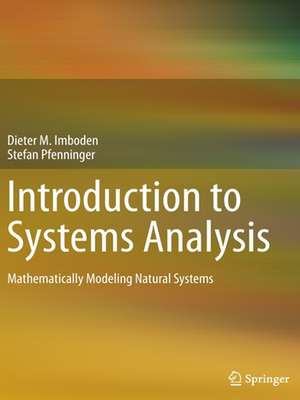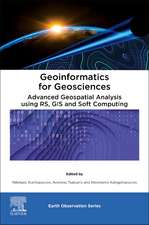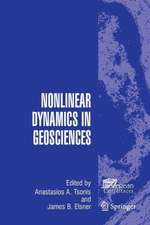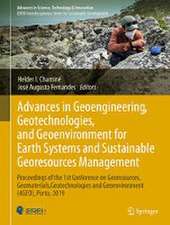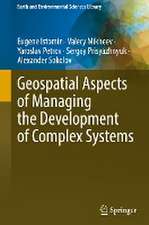Introduction to Systems Analysis: Mathematically Modeling Natural Systems
Autor Dieter M. Imboden, Stefan Pfenningeren Limba Engleză Paperback – 29 ian 2015
The focus is on developing the basic methods of modeling. Students will learn how to build mathematical models of their own, but also how to analyze the properties of existing models. The book neither derives mathematical formulae, nor does it describe modeling software, instead focusing on the fundamental concepts behind mathematical models. A formulary in the appendix summarizes the necessary mathematical knowledge. To support independent learners, numerous examples and problems from various scientific disciplines are provided throughout the book. Thanks in no small part to the cartoons by Nikolas Stürchler, this introduction to the colorful world of modeling is both entertaining and rich in content
| Toate formatele și edițiile | Preț | Express |
|---|---|---|
| Paperback (1) | 395.63 lei 6-8 săpt. | |
| Springer Berlin, Heidelberg – 29 ian 2015 | 395.63 lei 6-8 săpt. | |
| Hardback (1) | 405.53 lei 38-44 zile | |
| Springer Berlin, Heidelberg – 14 dec 2012 | 405.53 lei 38-44 zile |
Preț: 395.63 lei
Nou
Puncte Express: 593
Preț estimativ în valută:
75.70€ • 79.04$ • 62.65£
75.70€ • 79.04$ • 62.65£
Carte tipărită la comandă
Livrare economică 05-19 aprilie
Preluare comenzi: 021 569.72.76
Specificații
ISBN-13: 9783642430503
ISBN-10: 3642430503
Pagini: 260
Ilustrații: VIII, 252 p.
Dimensiuni: 210 x 279 x 14 mm
Greutate: 0.59 kg
Ediția:2013
Editura: Springer Berlin, Heidelberg
Colecția Springer
Locul publicării:Berlin, Heidelberg, Germany
ISBN-10: 3642430503
Pagini: 260
Ilustrații: VIII, 252 p.
Dimensiuni: 210 x 279 x 14 mm
Greutate: 0.59 kg
Ediția:2013
Editura: Springer Berlin, Heidelberg
Colecția Springer
Locul publicării:Berlin, Heidelberg, Germany
Public țintă
ResearchCuprins
1. Introduction.- 2. Mathematical models.- 3. Static models.- 4. Linear one dimensional models.- 5. Linear multi dimensional Models.- 6. Non-linear models.- 7. Time discrete models.- 8. Models in time and space.- A. List of symbols.- B. Dimensions and units.- C. Formulary.- D. Eigenvalues.- E. Time-dependent diffusion equation.- Bibliography.- Index.
Recenzii
From the book reviews:
“This book is a translation of the German text … by D. M. Imboden and S. Koch. It was developed on the basis of lecture notes for the course in Systems Analysis taught at the Swiss Federal Institute of Technology (ETH) Zürich for over twelve years and has been tested in the classroom many times. … Warmly recommended as a concise but comprehensive introduction to mathematical modeling.” (Svitlana P. Rogovchenko, zbMATH, Vol. 1302, 2015)
“Imboden and Pfenninger have written a marvelous book that explores detailed systems analysis for a large variety of systems. The book gives a gentle introduction to one-parameter systems with a simple lake model. … this book is an excellent overview of systems analysis with varied examples and detailed explanations. It is worth having in your library.” (David S. Mazel, MAA Reviews, February, 2014)
“This book is a translation of the German text … by D. M. Imboden and S. Koch. It was developed on the basis of lecture notes for the course in Systems Analysis taught at the Swiss Federal Institute of Technology (ETH) Zürich for over twelve years and has been tested in the classroom many times. … Warmly recommended as a concise but comprehensive introduction to mathematical modeling.” (Svitlana P. Rogovchenko, zbMATH, Vol. 1302, 2015)
“Imboden and Pfenninger have written a marvelous book that explores detailed systems analysis for a large variety of systems. The book gives a gentle introduction to one-parameter systems with a simple lake model. … this book is an excellent overview of systems analysis with varied examples and detailed explanations. It is worth having in your library.” (David S. Mazel, MAA Reviews, February, 2014)
Notă biografică
Dieter Imboden is Professor of Environmental Physics. His research concerns the study of physical processes in aquatic systems as well as problems of energy and climate politics. He is President of the Research Council of the Swiss National Science Foundation (SNSF)
Stefan Pfenninger joined IIASA’s Risk, Policy and Vulnerability Program (RPV) in January 2010. He is contributing to RPV's research on resilience, adaptation and renewable energy. Stefan holds a BSc in Environmental Science from ETH Zurich and an MSc in Environmental Technology from Imperial College London.
Stefan Pfenninger joined IIASA’s Risk, Policy and Vulnerability Program (RPV) in January 2010. He is contributing to RPV's research on resilience, adaptation and renewable energy. Stefan holds a BSc in Environmental Science from ETH Zurich and an MSc in Environmental Technology from Imperial College London.
Textul de pe ultima copertă
This book builds an understanding of what systems are and how they can be described mathematically. In the context of natural science, this knowledge is of great importance. The intended audience are students in applied sciences such as earth and environmental science, geoecology, environmental chemistry and forestry. The focus is on the methods of modeling, with the aim to let readers develop models of their own as well as analyze the properties of models they encounter. Numerous practical examples from the environmental sciences illustrate the concepts, and exercises accompany each chapter. The book is written so as to be easily understandable and includes humorous cartoons. There is no derivation of mathematical formulas or technical description of modeling software. It does, however, require an understanding of calculus for the reader to apply the mathematical methods it introduces.
Caracteristici
Gives a well-founded and comprehensive yet light introduction to modelling environmental systems Teaches how to build a model and describe that model mathematically in a way that lets the reader apply the principles to problems in various fields Detailed examples, exercises, and humorous cartoons make learning entertaining Suitable for self-study as well as for use in class Includes supplementary material: sn.pub/extras
